Blue dolphin cichlid (lat. Cyrtocara moorii) is an unusual tank fish which came from Malawi Lake in Africa. Blue dolphin cichlidis rather popular among cichlid-fans first of all due to its bright-blue color and also to its unusual body shape with a big bump on the fish head.
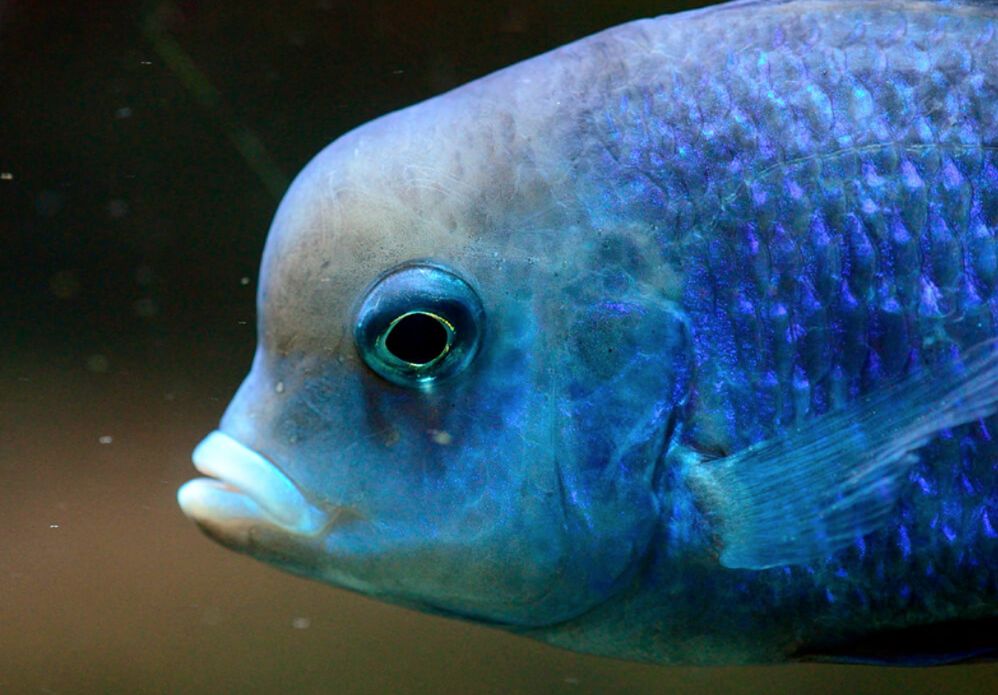
Contents
Habitat in the wild
Cyrtocara moorii was discovered and described by Boulanger in 1902. Is native to Lake Malawi in East Africa. African Malawi Lake endemic is rather spread through all the lake. Within the lake, it is found primarily along the rocky shores and sandy areas. It can be seen in the coastal regions 3-15 meters deep, it inhabits in the coastal biotopes with sandy bottom and performs feeding migrations along the coastline.
Blue dolphin cichlids inhabit the intermediate rocky zones of the lake, often congregating around large boulders and rocky outcrops. They prefer areas with sandy or gravel substrates, where they can sift through the sediment in search of food and dig pits for spawning.
In the wild, blue dolphin cichlids are part of the rocky shoreline community, which includes various other cichlid species. This community is characterized by complex rock formations, crevices, and caves that provide hiding places and territories for the fish. The rocks also serve as the backdrop for their mating rituals and territorial displays.
Blue dolphin cichlid forms stable multiple aged and intergroup communities. In the wild usually one male takes a dominant position and the rest of the fish has a dependent position. They are peaceful enough, but males can be rather aggressive to each other and it’s better to keep them in a harem consisting of one male and 3-4 females.
Such a harem inhabits in its own territory which is thoroughly guarded only during the spawning period. However, during the rest of time blue dolphin is more tolerate. There are some evidences that Cyrtocara moorii used to join some other species with alike habits and they used to feed together.
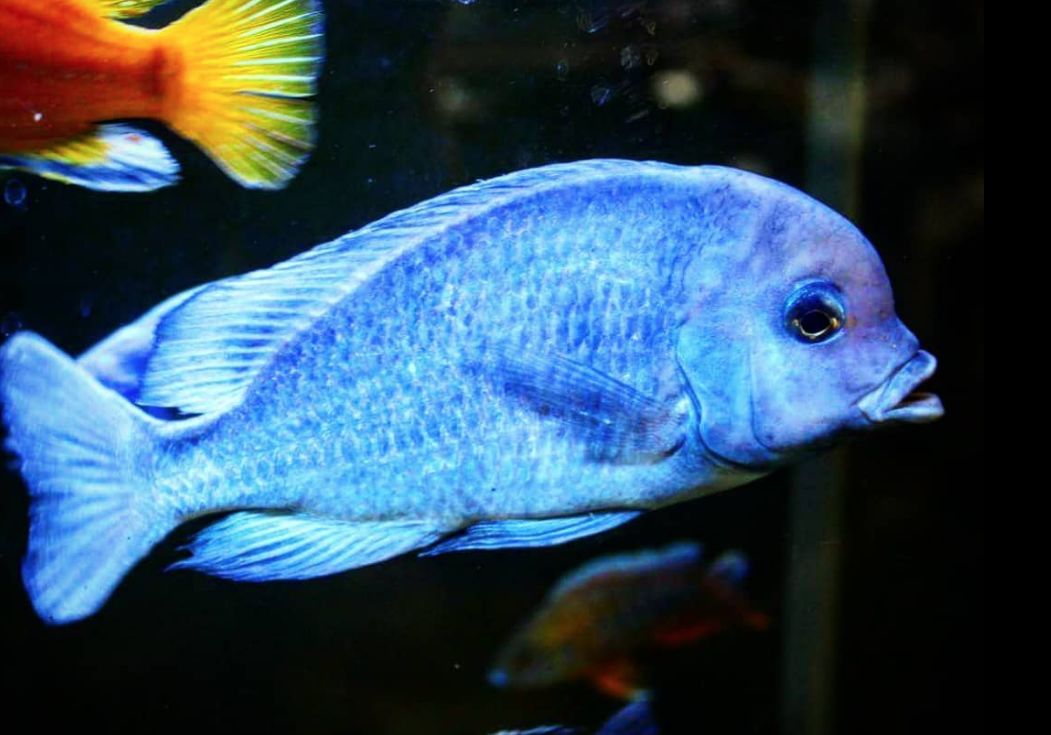
Description
Size
How big do blue dolphin cichlids get?
At that blue dolphin cichlid isn’t a small fish at all. Blue dolphin cichlids (Cyrtocara moorii) are moderately sized fish, with males typically growing larger than females. Here are the average size ranges for blue dolphin cichlids:
- Males: Blue dolphin cichlid males can reach a size of approximately 8 to 10 inches (20 to 25 centimeters) in length. Some exceptional individuals may even grow slightly larger.
- Females: Females of the species are generally smaller than males. They typically reach a size slightly smaller than the males, averaging around 6 to 8 inches (15 to 20 centimeters) in length.
Growth rate
Blue dolphin cichlids experience relatively rapid growth during their juvenile stage. In the first few months of their life, they can grow quite quickly, often reaching several inches in length within the first year. As blue dolphin cichlids enter their subadult stage, their growth rate typically slows down compared to their juvenile phase. They continue to grow but at a more moderate pace. Blue dolphin cichlids reach their adult size at around 2 to 3 years of age.
Lifespan
Blue dolphin cichlids have an average lifespan of approximately 8 to 10 years in captivity. However, with proper care and a suitable environment, they can sometimes live up to 12 years or even longer.
Body and color
It is a big fish with elongated body and with a head somehow reminding a dolphin that’s how the fish got its name. Blue dolphin cichlids have a unique and striking appearance. They have a laterally compressed body shape with a broad forehead and a slightly pointed snout. The coloration of adults is predominantly blue, hence the name “blue dolphin.” However, juveniles and females may exhibit more muted colors, such as brown or gray.
Body is elongated and stocky with a hump on its head and its snout is a bit pointed. Body color is blue with different number of black spots on the fins depending on the cichlid habitat.
When becoming older both males and females develop so called lump (also referred to as nuchal bump or hump) on their forehead. When the fish skirmish their fins and neck color changes up to almost black and the body color changes to bright blue.
| Characteristic | Description |
|---|---|
| Scientific Name | Cyrtocara moorii |
| Common Name | Blue Dolphin Cichlid, blue dolphin moorii, hap moorii, moori fish, moorii cichlid |
| Native to | Lake Malawi, East Africa |
| Size | Males: 8-10 inches (20-25 cm); Females: Slightly smaller than males |
| Body Shape | Laterally compressed with a broad forehead and pointed snout |
| Coloration | Adults: Predominantly blue; Juveniles and females: Muted colors (brown or gray) |
| Behavior | Generally peaceful and social, but can be aggressive |
| Diet | Omnivorous |
| Natural Habitat | Rocky shores and sandy areas of Lake Malawi |
| Water Parameters | Temperature: 75-82°F (24-28°C), pH: 7.5-8.5 |
| Breeding | Mouthbrooders: Females carry and protect fertilized eggs in mouth |
| Aquarium Care | Spacious tank with rocks and caves for hiding and territories |
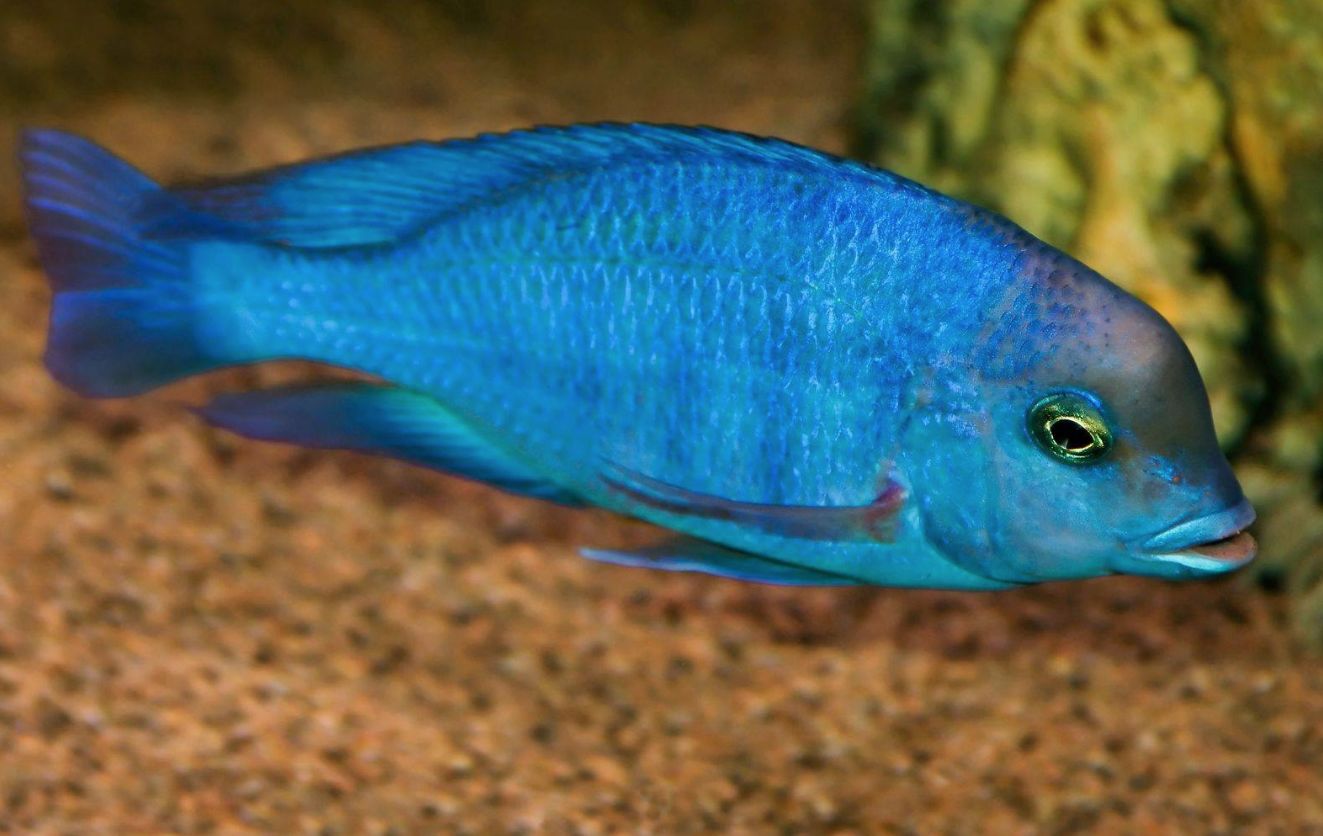
Difficulties in keeping
Keeping in a tank is rather easy under the condition that they live in a spacious aquarium with clean water that has stable parameters and the aquarium is designed appropriately. It’s better to design it as a biotop with a sandy bottom that has a big number of rocks and different covers which leave enough space for the fish to swim.
Is a fish to be recommended both to experienced and advanced aquarists. The blue dolphin cichlid isn’t the one for amateurs since it requires a spacious tank, frequent water renew and correctly chosen tank mates.
Although the fish is rather peaceful they aren’t good for a community tank. The best tank mates are some other Malawi fish types or african catfishes.
Care and keeping in a tank
Tank size
Blue dolphin cichlids are active and relatively large fish, so it is important to provide them with an adequately sized tank to ensure their well-being and comfort. The tank size for blue dolphin cichlids depends on whether you plan to keep them as a single specimen or as part of a community tank.
The main requirement when caring for the blue dolphin is a tank capacity. Its volume has to be at least 200-250 liters otherwise the fish would feel uncomfortable. Besides, in the big tanks fish can reach max size about 15-20 cm, if the tank is smaller the fish will be smaller correspondingly.
If you intend to keep a single blue dolphin cichlid, a tank size of at least 55 gallons (208 liters) would be suitable. This will provide enough swimming space and territory for the fish. If you plan to keep blue dolphin cichlids with other compatible fish species from Lake Malawi, such as mbuna cichlids, a larger tank is necessary to accommodate the aggression and territorial nature of these cichlids. For a community setup, a tank size of at least 75 gallons (283 liters) or more is recommended.
Also the main feature of male its big forehead won’t develop enough in a small tank. The covers are necessary, but the space for swimming should also be enough. Fish inhabits mainly in middle and low water layers.
Tank decor
As for the tank design – the bottom is better to be sandy where fish likes to dig. They don’t need any plants since they either dig them out or eat them.
It’s better to add lots of big rocks, snags and other types of covers in a tank. Also it’s recommended to keep blue dolphin cichlid in a species tank, since the fish is rather timid. In general, the fish is peaceful enough, though the males can sometimes have fights as for their dominance.
It’s desirable to have more females than males in a tank: for example, one male and two females or two females and three males.
Cichlid has a specific manner of behavior: it’s not fussy and its movements are slow. In Malawi Lake water parameters change insignificantly, plus the water is very hard and it has alkali reaction.
Water parameters
Optimal parameters for blue dolphin cichlid keeping are the following: pH 7.0-8.0, 10 – 25 dGH, the temperature 21–27 °C (70–81 °F).
Diet
As for the feeding type blue dolphin cichlid is closer to benthos feeders, but it doesn’t have a strict specialization in feed. In their natural habitat of Lake Malawi, they are opportunistic omnivores. Along with worms of benthic spineless the blue dolphin also feeds on organic debris, different kinds of drifting life and soft supreme phreatophyte.
Blue dolphin cichlids feed on algae, plant material, and detritus. They use their specialized pharyngeal teeth to scrape and graze on the surfaces of rocks and substrates in search of algae and biofilm. In an aquarium setting, it’s essential to provide them with a suitable vegetable-based diet. This can be accomplished by offering high-quality spirulina-based flakes or pellets, blanched vegetables like spinach or zucchini, and algae wafers.
In the tank eats all types of feed – artificial, live, frozen, plant one. But the feed should have high contain of proteins, for example, blood worms or brine shrimp, earthworms. In the wild, they feed on small invertebrates and insect larvae. In captivity, you can supplement their diet with high-quality cichlid pellets or flakes that contain a good balance of protein.
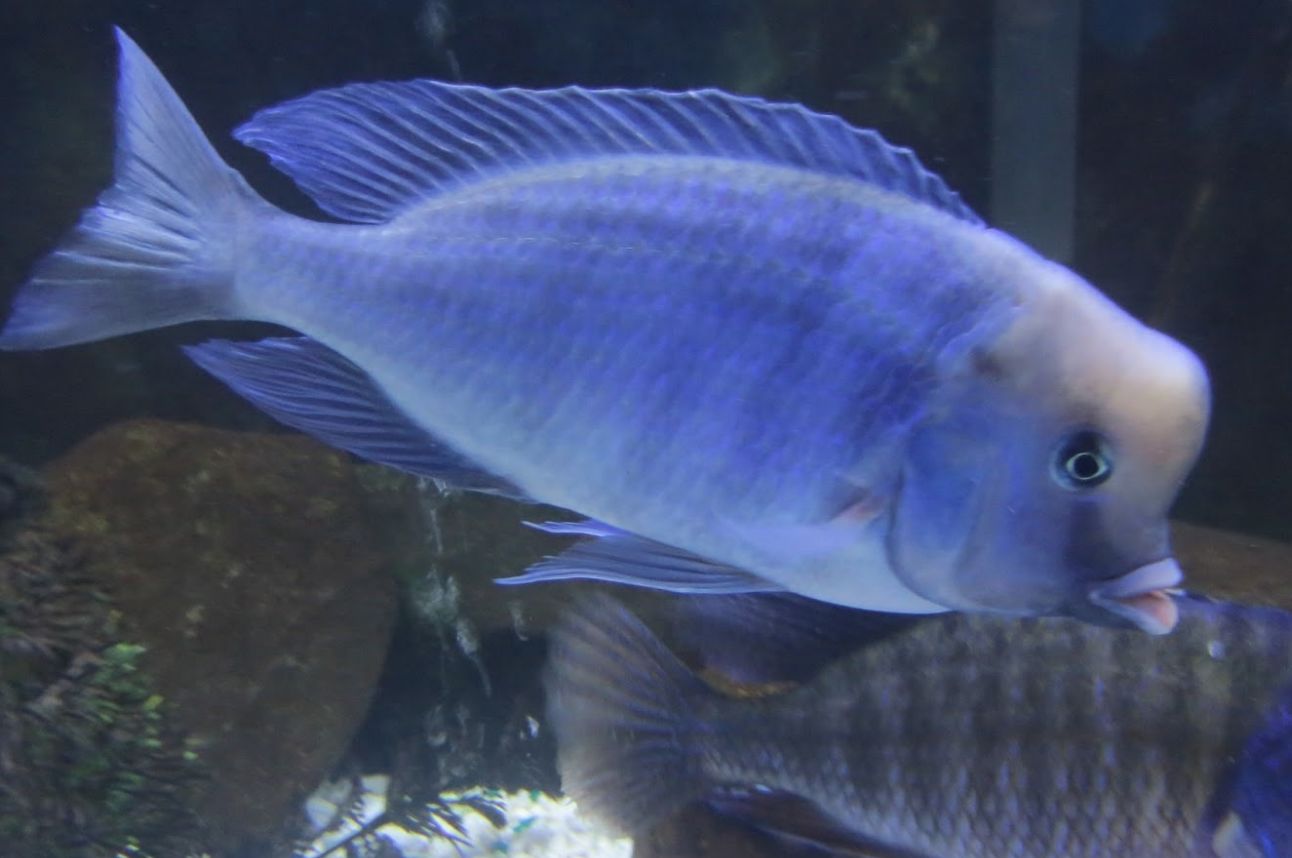
Tank mates
Are blue dolphin cichlids aggressive?
It’s a rather quiet cichlid, but the fish is sure not for the community tank. Cyrtocara moorii can display aggression, particularly during breeding and territorial disputes. However, compared to some other cichlid species, they are generally considered to be relatively peaceful. Their aggression is typically less pronounced when compared to more aggressive mbuna cichlids found in Lake Malawi.
It’s important to note that individual fish may exhibit varying levels of aggression, and their behavior can also be influenced by factors such as tank size, water parameters, and the presence of other fish in the aquarium. Providing enough space, hiding spots, and territories within the tank can help minimize aggression among blue dolphin cichlids and promote a more harmonious environment.
Blue dolphin cichlid can inhabit together with other Malawi fishes, but it’s desirable to avoid mbuna, because its very aggressive and disquiet. In some cases, peaceful cichlid species from Lake Tanganyika can also be compatible with blue dolphin cichlids. Look for species such as Julidochromis, Neolamprologus, or some Altolamprologus species.
They are good tank mates for with the fish of equal size, but smaller fish is treated only as feed. It’s good to have frontosa cichlid and big african like sailfin pleco as tank mates. Some non-cichlid fish can also be compatible tank mates for blue dolphin cichlids. Peaceful bottom-dwelling species like certain species of catfish (e.g., Corydoras or Synodontis) can work well.
Gender differences: male vs female
In blue dolphin cichlids (Cyrtocara moorii), there are some notable differences between males and females in terms of appearance and behavior. Here are the key distinctions:
- Males are more often larger and brighter. Males can reach an average length of 8 to 10 inches (20 to 25 centimeters), while females are slightly smaller, usually around 6 to 8 inches (15 to 20 centimeters). Adult male blue dolphin cichlids typically exhibit more vibrant and intense colors compared to females. Males display a striking blue hue on their bodies, which is where the species gets its common name. In contrast, females and juveniles have more subdued colors, often appearing brown or gray.
- The hump gradually develops on the forehead of cichlid males and females. Males may have a more pronounced forehead and a slightly more elongated body compared to females. However, these differences in body shape are not as significant as the differences in coloration.
- Male blue dolphin cichlids can be more aggressive and territorial, particularly during breeding or when establishing dominance.
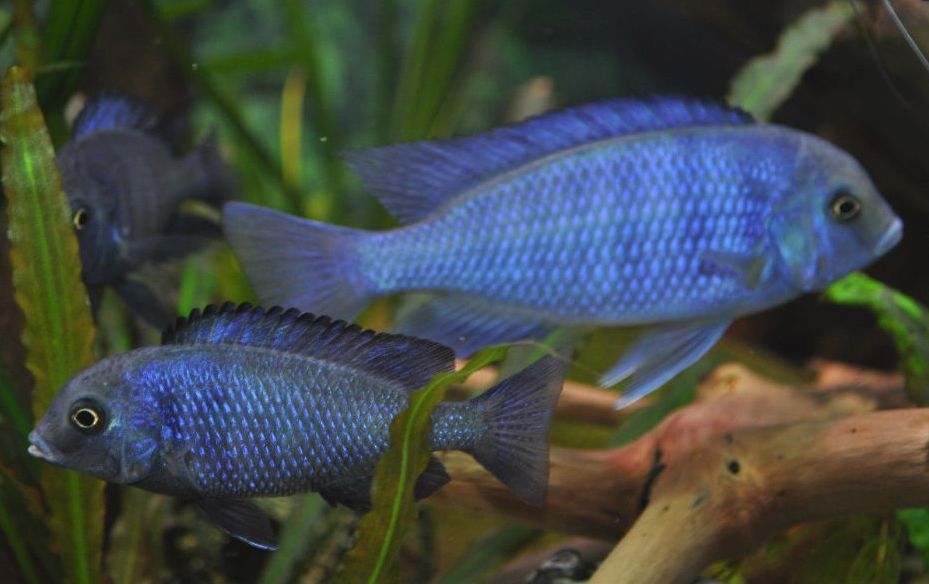
Breeding
They are polygamous, they create a family consisting of a male and several females. There can be 3-6 females for one male. Since the gender of a fish is difficult to be defined, the best way is to create a harem of 10 juveniles and grow them together.
The blue dolphin cichlid juveniles become reproductive when reaching the body length 12-15 cm and then they should be separated. Water parameters for breeding are the following: hardness 5 -20°, pH 7.5-9.0, temperature 25 – 28 °C. The couple takes part in spawning.
Male becomes rather aggressive when protecting its territory, as for the female it becomes timid (when it gets scared it can swallow the eggs) therefore it should be protected from stress.
The blue dolphin cichlid female breeds on a flat rock or into the hole dug by the male in advance, or just on the bottom. The female breeds 1-3 eggs in a time, then she takes them into her mouth and gets to the male anal fin to fertilize them.
The fruitfulness of the couple is from 20 to 90 eggs. The female carries eggs in its mouth for 21 days. During this period the female doesn’t eat a thing and it can get weak, therefore some aquarists try to grow the eggs in an incubator. To do so they take a spawned-out female and release the eggs from her mouth.
They put the eggs into the tank with clean water, soft lights and water passage. The water should have the same parameters that the one in the big tank.
On the 7th day the blue dolphin cichlid juveniles start going outside and feed, but hey hide back into the female mouth with the slightest sign of danger or for the night time. Start feed is brine shrimp eggs.
The juveniles from the beginning are silver colored with black stripes and than when reaching 4-5 cm in size they become blue and grow very slowly.